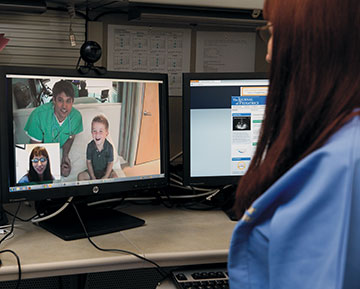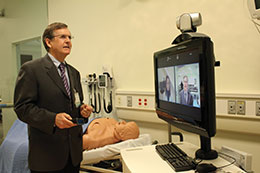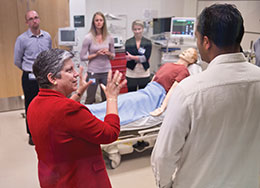Volume 31 · Number 3 · Summer 2014
The doctor is online
Telemedicine is leading a revolution in connecting people to better health care.

As the Affordable Care Act rolls out, connected health will become even more integrated into the nation’s medical
fabric. UC Davis is already there.
(Photo by Robert Durell)
America is facing a health-care conundrum. While the Affordable Care Act is expanding coverage for millions, no one is sure how these additional patients will impact the system. How do we find medical homes for the newly insured? Will there be enough physicians? Can hospitals handle the extra load?
Part of the solution may come from the burgeoning field of connected health, which includes telehealth, networked devices, smart phone apps and electronic health records. The same technologies that power business teleconferences can also enhance communication between physicians and patients.
“If we are going to use our current provider work force to care for patients already being treated, plus the millions of new folks who will be seeking care as a result of health-care reform, we will have to expand our tool set beyond the office visit,” says Joseph Kvedar, who directs the Center for Connected Health in Boston. “Connected health is a big part of the solution.”
Front and center in creating that solution is the UC Davis Health System. For more than two decades, UC Davis has been a leader in telehealth — enhancing patient care and bringing specialist expertise to underserved areas.

Thomas Nesbitt, associate vice chancellor for Strategic Technologies and Alliances, says: “Telemedicine is all about reducing geographic disparities. It’s about getting the right xpertise to the right people at the right time.“ (Photo by Robert Durrell)
UC Davis began pioneering telemedicine in 1992, when family physician Thomas Nesbitt ’75, M.D. ’79, established a telefetal-monitoring project that connected specialists with a Colusa County hospital. The project allowed the small community hospital to reopen its obstetrics program and deliver babies again for the first time after a four-year hiatus.
Nesbitt’s concern about disparities in rural health care goes back to the earliest days of his career. As a resident and young doctor in eastern Washington and northern Idaho in the 1980s, he treated women who had received little or no prenatal care.
“I saw firsthand how the lack of specialists at a small community hospital could reduce care,” said Nesbitt, who joined the UC Davis faculty in 1988 and has focused on improving health care access ever since.
Telehealth proved to be a “great solution,” said Nesbitt, who, as associate vice chancellor for strategic technologies and alliances, oversees UC Davis’ application of technology-enabled care and education.
“Telemedicine is all about reducing geographic disparities,” he said. “It’s about getting the right expertise to the right people at the right time.”
The fetal monitoring project, and other programs spearheaded by Nesbitt, evolved into UC Davis’ Center for Health and Technology. The advanced telemedicine program now provides access to more than 30 specialties, including dermatology, psychiatry, orthopaedics and endocrinology, to patients and their doctors at more than 100 clinics and hospitals in Northern California.
“If you’re living an hour or two outside an urban center, your access to specialists drops off considerably,” said Aaron Bair, the center’s medical director.
With the spread of wireless devices and other technological advances, telemedicine is increasingly able to close that geographic divide.
“Early on, you had to spend $50,000 or $60,000 dollars for a teleconferencing system,” Bair said. “That was for just one machine, and naturally you needed at least two to talk to anyone. Now you can do pretty much everything on an iPad with a secure connection.”

UC President Janet Napolitano chats with Nathaniel Lara, a physician assistant student from the Betty Irene Moore School of Nursing, during a visit last year to UC Davis’ Center for Virtual Care. Lara and classmates Dale Risenhoover, left, Brittany Gerali and Allison O’Brien were practicing procedures on computer-controlled lifelike mannequins. (Photo by Robert Durrell)
Expanding reach
A new program — Pediatric Emergency Assistance to Newborns Using Telehealth, or PEANUT — provides rural clinicians 24/7 access to pediatric specialists in the most commonly needed subspecialties to treat respiratory distress, pneumonia, hypoglycemia, sepsis and other conditions. The program is funded by the U.S. Department of Health and Human Services Office for the Advancement of Telehealth.
Another UC Davis program, HEALTH-COP — Healthy Eating Active Living TeleHealth Community of Practice — creates a virtual learning network to help doctors provide better care and counseling to families struggling with obesity.
The UC Davis Comprehensive Cancer Center uses the technology to conduct virtual tumor boards with its cancer center network. The sessions bring together a range of medical disciplines to address how to improve care for cancer patients.
The technology is also helping researchers conduct clinical and population health studies. In one trial, clinicians were able check in with patients who are too sick to leave the house.
“There have to be follow-up visits,” says Hien Nguyen, medical director of the health system’s electronic medical records. “Patients who are sick with the flu don’t want to come in. With telemedicine, mobile nurses can visit patients, and they don’t have to go anywhere.”
A ‘pre-eminent’ program
The Center for Health and Technology also offers training for health care providers interested in setting up their own telemedicine programs.
A recent two-day lecture and hands-on class drew participants from Iowa, Kansas, Minnesota, Michigan, Colorado and Ohio. The class explained the ins and outs of telehealth, including equipment types, billing arrangements, public policy and even how to overcome technical difficulties.
“Our technicians run participants through trouble-shooting scenarios,” Bair said. “Sometimes it’s good to break the machine, so to speak, and have the technical team demonstrate how to fix it.”
To make these interventions as realistic as possible, the program utilizes high-tech training labs, mock exam rooms and consultation suites for hands-on experiences.
Nearly 2,000 people from 800 organizations around the world have taken the courses.
“UC Davis boasts the pre-eminent connected health program in California, and is one of a handful of successful programs in the U.S.,” says Kvedar of Boston’s Center for Connected Health. “The Center for Health and Technology is recognized for its innovation in technology-enabled care, education and research. This is great for patients because it gives them the tools to manage their health, rather than having to schedule time, travel, parking and waiting.”
UC Davis’ Bair said telemedicine holds even greater promise for reducing unnecessary hospitalizations and improving quality of life for millions of patients.
“The potential,” he said, “is enormous.”
